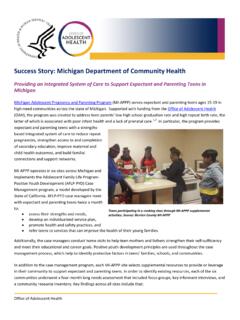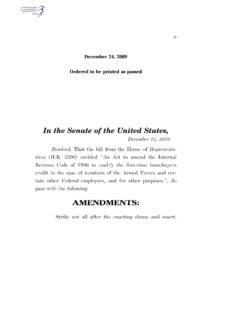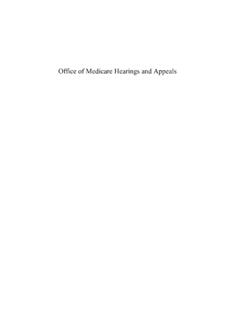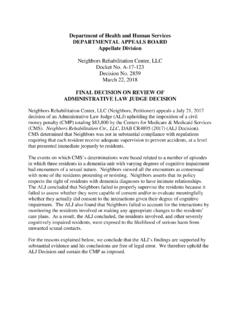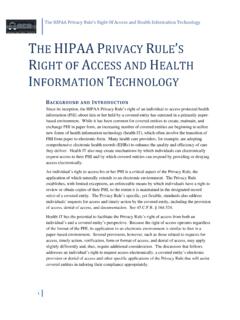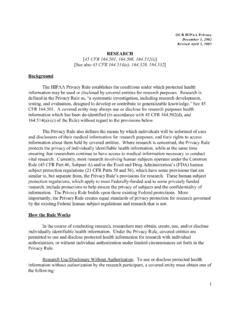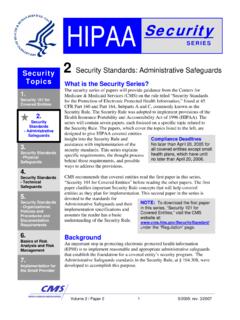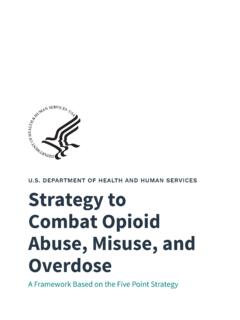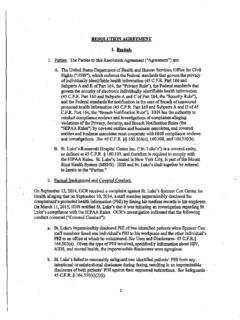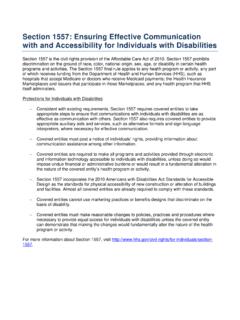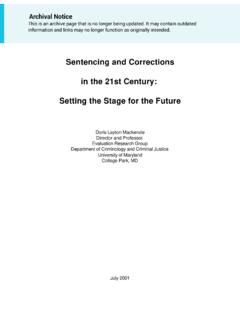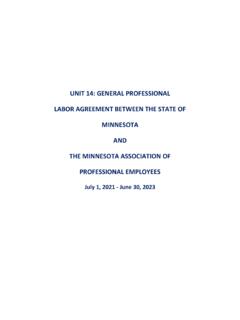Transcription of 2021 SEP Final Enrollment Report
1 1 2021 Final MARKETPLACE SPECIAL Enrollment PERIOD Report The Health Insurance Marketplaces 2021 Special Enrollment Period (SEP) Report summarizes health insurance Enrollment activity through the individual Marketplaces during the 2021 SEP. In response to the COVID-19 Public Health Emergency, all state Marketplaces opened an SEP this year that allowed consumers without other qualifying life events to enroll outside of the annual Open Enrollment Period. This Report includes SEP data for the 36 states that use the eligibility and Enrollment platform for the 2021 plan year ( states), where the SEP ran from February 15 through August 15, 2021, and for the 15 State-based Marketplaces (SBMs) that use their own eligibility and Enrollment platforms, for which reporting dates During the 2021 SEP, the American Rescue Plan Act of 2021 (ARP) was signed into law and implemented in the Marketplaces.
2 Under the ARP, more generous advance payments of premium tax credits (APTC) have become available to most consumers, further reducing This Report also includes data on the benefits of the ARP for consumers in all 50 states, plus the District of Columbia. Key findings from this Report include: Total Marketplace Signups: Over million Americans signed up for new health insurance coverage through and State-based Marketplaces during the 2021 Marketplace SEP. Plan Selections: In states, million Americans signed up for new health insurance coverage using the 2021 Marketplace SEP between February 15 and August 15. State-based Marketplace Plan Selections: Across the 15 SBMs, 738,000 Americans have signed up for new health insurance coverage through the 15 State-based Marketplaces through the end of their respective reporting California, Connecticut, DC, Nevada, New Jersey, New York and Vermont are continuing their SEP through the end of the year.
3 1 New Jersey and Pennsylvania transitioned to State-based Marketplaces in 2020, and Nevada transitioned to a State- based Marketplace in 2019. Plan selections from these three states aren t included in the data in this Report . 2 implemented the ARP s expanded APTC eligibility and amounts for all consumers on April 1, 2021, and implemented a further APTC and cost-sharing reduction (CSR) expansion on July 1, 2021, for those consumers who received or are approved to receive unemployment compensation for any week beginning in 2021. The State-based Marketplaces implemented these ARP expansions on different schedules. 3 Due to some SBMs corrections of previously reported new plan selection counts, SBM new plan selections through July 31 were revised to 635,000, from 723,000 reported here: Total SEP new plan selections for all 50 states plus the District of Columbia through July 31,2021 were million.
4 2 Demographic Trends: Due to the ARP expansion, consumers with a household income over 400% FPL represented a greater proportion of plan selections compared to the same period in past years, increasing from less than 2 percent in 2019 and 2020 to 7 percent in 2021. The 2021 SEP also attracted a more diverse group of consumers in states. Among consumers who attested to a race or ethnicity, 15 percent identified as African American, compared to 9 percent and 11 percent in 2019 and 2020, respectively. The percentage of consumers who self-reported as Hispanic/Latino increased to 19 percent, from 16 percent in 2019 and 2020. Geographic Trends: In several states that have not expanded Medicaid, there are counties with an average of at least 40 new plan selections per one thousand nonelderly residents--a notable contrast from states that have expanded Medicaid, where 96 percent of counties had 15 or fewer new plan selections per every one thousand nonelderly residents.
5 Consumer Savings: The ARP has substantially reduced enrollee premiums, as well as cost-sharing, by making richer coverage more affordable. Premiums: o Nationwide, existing consumers with a new or updated plan selection after ARP implementation saved an average of $67 (or 50%) per consumer per month on premiums, totaling $537 million per month in savings. In twenty states and the District of Columbia, existing consumers saved over $75 per month, on average, due to the ARP APTC expansion. o Nearly half of consumers with a new plan selection from February 15 to August 15 had a monthly premium of $10 or less, compared to 25 percent during the same period in 2020. o Across the SBMs, 33 percent of consumers with a new plan selection had a monthly premium of $10 or less.
6 Following implementation of ARP in the SBMs, consumers saw substantial premiums savings of approximately $95 per month. Cost-Sharing: The median deductible for new consumers selecting plans through between February 15 and August 15 decreased by more than 90 percent, from $750 in 2020 and 2019 to $50 in 2021. Over 40 percent of new consumers signing up during the 2021 SEP enrolled in plans that cover 94 percent of their expected health care costs (94% actuarial value), which the ARP made available to most consumers with an income between 100% and 150% of the Federal Poverty Level (FPL) for a $0 premium. NEW SEP PLAN SELECTIONS THROUGH THE MARKETPLACES Over million consumers enrolled in a Marketplace plan during the 2021 SEP. This includes 3 million consumers in states using the platform (see Table 1) and 738,000 consumers in SBMs using their own platforms (see Table 2).
7 In states, the number of new plan selections from the start of the SEP on February 15, 2021, through August 15, 2021, was nearly three times the Enrollment during the same time period in 2020 and nearly four times the Enrollment during the same period in 2019. In SBM states, the number of new plan selections in this Report reflects the timeframe of each SBM s active 2021 SEP, which varied by state. Some SBMs will continue to operate their SEPs through the end of the year and reported data through August 31, 2021. The data provided is only for the SBMs 2021 SEPs and does not include new plan selections during SBM 2020 SEP windows, which most SBMs implemented in response to the COVID-19 Public Health Emergency. Figure 1 shows 2021 SEP new plan selections per 1,000 nonelderly residents by county for states and by state for SBM states.
8 While only 33 percent of the nonelderly population live in states that have not expanded Medicaid, they accounted for 55 percent of Enrollment during the 2021 Medicaid non-expansion states saw much higher Enrollment rates than expansion states, with average Enrollment per 1,000 nonelderly residents times that of expansion states, likely due to higher baseline uninsured rates in non-expansion states. Table 1: New SEP Plan Selections in States, February 15 August 15 New SEP Plan Selections by State, February 15 August 15 State 2021 2020 2019 Total 2,069,596 751,835 554,385 Alaska 4,069 1,460 1,421 Alabama 42,094 13,084 9,243 Arkansas 19,390 6,175 6,107 Arizona 40,827 13,678 13,060 Delaware 5,882 2,583 2,036 Florida 542,067 222,588 152,295 Georgia 147,463 41,138 25,656 Hawaii 4,130 3,014 1,949 Iowa 15,246 6,644 5,875 Illinois 54,432 25,272 22,958 Indiana 27,984 11,810 11,375 Kansas 21,220 7,693 6,124 4 For the purposes of this Report , Missouri is categorized as a non-expansion state since its expansion of Medicaid will not take effect until 10/1.
9 Oklahoma is categorized as neither a Medicaid expansion nor non-expansion state, as its expansion took place on 7/1 in the middle of the 2021 SEP. 4 New SEP Plan Selections by State, February 15 August 15 State 2021 2020 2019 Kentucky 20,827 7,522 8,613 Louisiana 17,608 6,537 7,567 Maine 10,583 4,755 4,107 Michigan 47,306 22,730 20,253 Missouri 52,143 16,531 11,608 Mississippi 32,441 9,269 5,545 Montana 7,653 3,782 3,369 North Carolina 124,246 39,344 30,235 North Dakota 5,316 2,066 1,693 Nebraska 15,498 7,205 6,565 New Hampshire 9,004 4,353 3,998 New Mexico 9,203 2,961 3,062 Ohio 48,560 19,273 16,259 Oklahoma 37,259 19,258 14,251 Oregon 22,743 12,354 12,036 South Carolina 59,713 17,214 11,277 South Dakota 7,644 2,715 2,416 Tennessee 57,934 18,961 11,761 Texas 416,987 121,226 66,031 Utah 42,925 18,084 16,721 Virginia 54,518 19,876 18,577 Wisconsin 33,716 16,411 16,908 West Virginia 4,195 1,773 1.
10 495 Wyoming 6,770 2,496 1,939 Table 2: 2021 New SEP Plan Selections in SBM States New SEP Plan Selections by SBM State Total 737,922 California 338,557 Colorado 36,396 Connecticut 18,535 District of Columbia 2,433 Idaho 3,920 Maryland 17,217 Massachusetts 44,179 Minnesota 16,583 Nevada 21,450 5 New SEP Plan Selections by SBM State New Jersey 63,028 New York 47,116 Pennsylvania 64,900 Rhode Island 6,564 Vermont 4,517 Washington 52,527 6 Figure 1: 2021 New SEP Plan Selections per 1,000 Nonelderly Residents5 5 Data for states are at the county level, while SBM data are at the state level because county-level SBM Enrollment data were not available at the time of this Report . In counties with 1 to 10 plan selections, statewide median values were used in place of the county-level new plan selections per 1,000 nonelderly residents.
